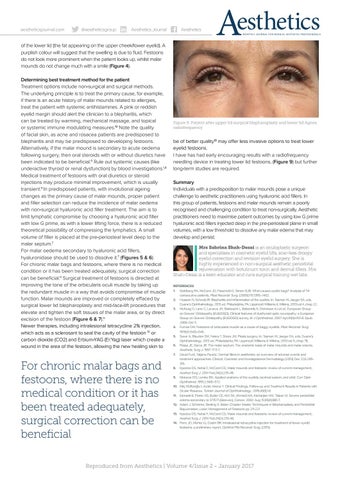aestheticsjournal.com
@aestheticsgroup
Aesthetics Journal
Aesthetics
of the lower lid (the fat appearing on the upper cheek/lower eyelid). A purplish colour will suggest that the swelling is due to fluid. Festoons do not look more prominent when the patient looks up, whilst malar mounds do not change much with a smile (Figure 4). Determining best treatment method for the patient Treatment options include non-surgical and surgical methods. The underlying principle is to treat the primary cause, for example, if there is an acute history of malar mounds related to allergies, treat the patient with systemic antihistamines. A pink or reddish eyelid margin should alert the clinician to a blepharitis, which can be treated by warming, mechanical massage, and topical or systemic immune modulating measures.10 Note the quality of facial skin, as acne and rosacea patients are predisposed to blepharitis and may be predisposed to developing festoons. Alternatively, if the malar mound is secondary to acute oedema following surgery, then oral steroids with or without diuretics have been indicated to be beneficial.11 Rule out systemic causes (like underactive thyroid or renal dysfunction) by blood investigations.1,3 Medical treatment of festoons with oral diuretics or steroid injections may produce minimal improvement, which is usually transient.11 In predisposed patients, with involutional ageing changes as the primary cause of malar mounds, proper patient and filler selection can reduce the incidence of malar oedema with non-surgical hyaluronic acid filler treatment. The aim is to limit lymphatic compromise by choosing a hyaluronic acid filler with low G prime, as with a lower lifting force, there is a reduced theoretical possibility of compressing the lymphatics. A small volume of filler is placed at the pre-periosteal level deep to the malar septum.7 For malar oedema secondary to hyaluronic acid fillers, hyaluronidase should be used to dissolve it.7 (Figures 5 & 6) For chronic malar bags and festoons, where there is no medical condition or it has been treated adequately, surgical correction can be beneficial.11 Surgical treatment of festoons is directed at improving the tone of the orbicularis oculi muscle by taking up the redundant muscle in a way that avoids compromise of muscle function. Malar mounds are improved or completely effaced by surgical lower lid blepharoplasty and mid-face-lift procedures that elevate and tighten the soft tissues of the malar area, or by direct excision of the festoon (Figure 6 & 7).11 Newer therapies, including intralesional tetracycline 2% injection, which acts as a sclerosant to seal the cavity of the festoon 12 or carbon dioxide (CO2) and Erbium-YAG (Er:Yag) laser which create a wound in the area of the festoon, allowing the new healing skin to
For chronic malar bags and festoons, where there is no medical condition or it has been treated adequately, surgical correction can be beneficial
Figure 9: Patient after upper lid surgical blepharoplasty and lower lid Agnes radiofrequency
be of better quality10 may offer less invasive options to treat lower eyelid festoons. I have has had early encouraging results with a radiofrequency needling device in treating lower lid festoons, (Figure 9) but further long-term studies are required. Summary Individuals with a predisposition to malar mounds pose a unique challenge to aesthetic practitioners using hyaluronic acid fillers. In this group of patients, festoons and malar mounds remain a poorly recognised and challenging condition to treat non-surgically. Aesthetic practitioners need to maximise patient outcomes by using low G prime hyaluronic acid fillers injected deep in the pre-periosteal plane in small volumes, with a low threshold to dissolve any malar edema that may develop and persist. Mrs Sabrina Shah-Desai is an oculoplastic surgeon and specialises in cosmetic eyelid lifts, scar-less droopy eyelid correction and revision eyelid surgery. She is highly experienced in non-surgical aesthetic periorbital rejuvenation with botulinum toxin and dermal fillers. Mrs Shah-Desai is a keen educator and runs surgical training wet labs. REFERENCES 1. Goldberg RA, McCann JD, Fiaschetti D, Simon GJB. What causes eyelid bags? Analysis of 114 consecutive patients. Plast Reconstr Surg. (2005);115:1395–1402. 2. Hussein N, Schwab IR. Blepharitis and Inflammation of the eyelids. In: Tasman W, Jaeger EA, eds. Duane’s Ophthalmology. 2013 ed. Philadelphia, PA: Lippincott Williams & Wilkins; 2013:vol 4, chap 22. 3. McKeag D, Lane C, Lazarus JH, Baldeschi L, Boboridis K, Dickinson AJ et al., European Group on Graves’ Orbitopathy (EUGOGO), Clinical features of dysthyroid optic neuropathy: a European Group on Graves’ Orbitopathy (EUGOGO) survey, Br J Ophthalmol. 2007 Apr;91(4):455-8. Epub 2006 Oct 11. 4. Furnas DW. Festoons of orbicularis muscle as a cause of baggy eyelids. Plast Reconstr Surg. 1978;61:540–546. 5. Savar A, Blaydon SM, Nakra T, Shore JW. Ptosis surgery. In: Tasman W, Jaeger EA, eds. Duane’s Ophthalmology. 2013 ed. Philadelphia, PA: Lippincott Williams & Wilkins; 2013:vol 5, chap 78. 6. Pessa JE, Garza JR. The malar septum: The anatomic basis of malar mounds and malar edema. Aesthetic Surg J. 1997. 17:11-7. 7. David Funt, Tatjana Pavicic. Dermal fillers in aesthetics: an overview of adverse events and treatment approaches. Clinical, Cosmetic and Investigational Dermatology (2013) Dec 12;6:295316. 8. Kpodzo DS, Nahai F, McCord CD, Malar mounds and festoons: review of current management, Aesthet Surg J. 2014 Feb;34(2):235-48. 9. Kikkawa DO, Lemke BN. Applied anatomy of the eyelids, lacrimal system, and orbit. Curr Opin Ophthalmol. 1991;2:568–572. 10. Kılıç Müftüoğlu İ, Aydın Akova Y. Clinical Findings, Follow-up and Treatment Results in Patients with Ocular Rosacea. Turkish Journal of Ophthalmology. 2016;46(1):1-6 11. Esmaeli B, Prieto VG, Butler CE, Kim SK, Ahmadi MA, Kantarjian HM, Talpaz M, Severe periorbital edema secondary to STI571 (Gleevec), Cancer. 2002 Aug 15;95(4):881-7. 12. Adam J. Scheiner, Sterling S. Baker Chapter Master Techniques in Blepharoplasty and Periorbital Rejuvenation, Laser Management of Festoons pp 211-221 13. Kpodzo DS, Nahai F, McCord CD, Malar mounds and festoons: review of current management, Aesthet Surg J. 2014 Feb;34(2):235-48. 14. Perry JD, Mehta VJ, Costin BR, Intralesional tetracycline injection for treatment of lower eyelid festoons: a preliminary report, Ophthal Plst Reconstr Surg, (2015)
Reproduced from Aesthetics | Volume 4/Issue 2 - January 2017
